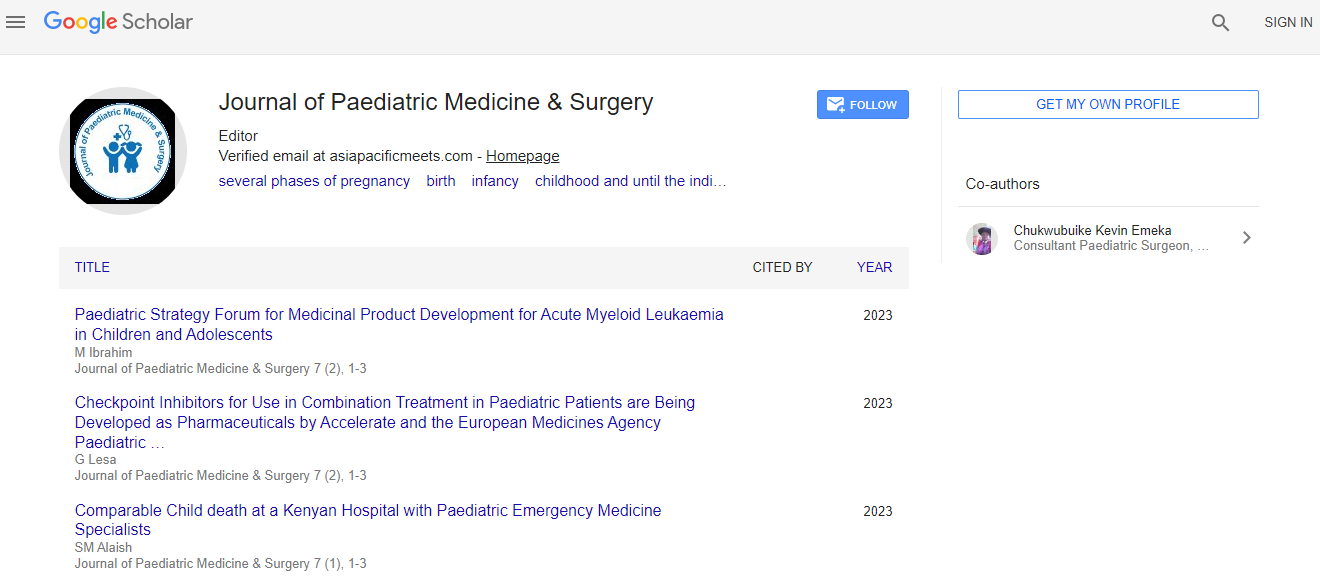Pediatrics Health 2020: Effect of diet modification on attention deficit hyperactivity disorder outcome and its relation to serum sphingosin -1-phosphate - Rania Nabil Sabry - National Research Centre
*Corresponding Author:
Copyright: © 2020 . This is an open-access article distributed under the terms of the Creative Commons Attribution License, which permits unrestricted use, distribution, and reproduction in any medium, provided the original author and source are credited.
Abstract
Background: ADHD is one of the most common neurodevelopmental disorders, affect 5% of children worldwide and characterized by impairing inattention, hyperactivity and impulsivity and can be avoided by excluding risk factors such as food. Sphingosin- 1-phosphate (S1P) is thought to have role in neuropsychiatric disorders, immunological diseases/allergic reactions and disturbances in its metabolic pathway were associated with intake of some foods and nutrients. Lipids play many roles in a properly functioning organism including energy storage, signal transmission, cell membrane building blocks, etc. The main component of cell membranes are lipids called phospholipids with a phosphate group within their structure. Due to their structure, lipids are both hydrophobic (hydrocarbon chains) and hydrophilic (polar functional groups). In aqueous environments, such as cells, phospholipids turn their polar heads to water molecules, whereas the hydrophobic tails cluster together, creating a lipid bilayer. The lipid bilayer is fluid and within the structure there are embedded proteins which can change their position. Fluidity of the cell membrane can be influenced by, e.g. lipid composition temperature and the type of fatty acids within the phospholipid. Fatty acid chains interact with each other and that interaction is responsible for the membrane’s properties. For instance, fluidity of the cell membrane increases if there are more unsaturated fatty acids in its structure, as they are more bulky as a result of the bend in the carbon chain from the double bond. Similarly, if there are more saturated fatty acids within the cell membrane, it becomes more compact and, therefore, its fluidity decreases. The length of the fatty acid chain also plays a role in the fluidity of the membrane: shorter chains increase fluidity as there are less hydrophobic interactions between the tails. Lipids and lipid metabolism have been linked to many disorders, both somatic and neuropsychiatric. McEwen and Stellar proposed that exposure to frequent and chronic environmental stressors may produce insufficient or overreacting responses, resulting in cumulative damage that physiologic systems have endured in the process of adapting to stressors, increasing the risk of disease. Theoretical construction of allostatic load is associated with dysregulation of lipid metabolism and can lead to disease. The biological relationship of mental disorders and the “stress response” involves a series of complex, interactive neurophysiological reactions in the brain, the autonomic nervous system, adrenocortical (HPA) axis, immune system and platelet adhesion. The neurochemical system mediating the stress response becomes more “sensitive” to future stressors related to the original experience. Dysregulated lipid metabolism may be of particular importance for central nervous system (CNS) injures and a disorder as the CNS has the highest lipid concentration next to adipose tissue. The exact pathophysiological mechanism linking lipids and mental disorders is still debatable. There are several hypotheses explaining the connection between lipids (fatty acids) and neuropsychiatric disorders. These hypotheses include: 1) the fact that docosahexaenoic acid (DHA) is greatly abundant in neuronal cells and therefore its insufficiency may alter the properties of the neuronal cell membranes or even the nerve growth factors; and 2) the relationship and changes in signal transduction caused by phosphatidylinositol turnover and protein kinase C activity. Mirnikjoo and co-authors show in experiments that in vitro eicosapentaenoic acid (EPA) and DHA reduced the activity of cAMP-dependent protein kinase A, protein kinase C (PKC) and mitogen-activated protein kinase (MAPK). Lipid and electrolyte abnormalities have an impact on neuronal disturbance.
Aim: The study aimed to assess effect of diet modification on ADHD outcome, the role of food as a precipitating factor for ADHD symptomatology and its relation to serum S1P.
Patients and methods: the study included 47 children newly diagnosed with ADHD, not receiving medical or behavioral therapy, 6-9 years, IQ not below 70 with no associated comorbidities. Full history was taken; clinical examination, anthropometric measurements, 24 hour dietary recall, dietary analysis, Conner’s parent rating scale-revised short form and serum S1P were done before and after diet modification program for 5 weeks.
Results: There was improvement in ADHD symptoms as measured by Conner’s parent rating scale-revised short form (CPR-RS) after 5-weeks of diet modification program. Carbohydrate and protein intake decreased significantly after diet modification program. Energy intake did not show statistical difference while fat intake increased significantly after the diet program. Vitamin A, C, riboflavin, thiamin and iron intakes decreased significantly after diet program but were within the recommended dietary allowance. Serum S1P levels decreased significantly after diet modification
Conclusion: Following health education tips and diet modification program improved symptoms of ADHD as documented by decrease of CPR scores with concomitant decrease of serum S1P. Dietary carbohydrate and protein intakes were positively correlated with Conner’s parent rating scale-revised short (CPR-RS) scores and S1P.

 Spanish
Spanish  Chinese
Chinese  Russian
Russian  German
German  French
French  Japanese
Japanese  Portuguese
Portuguese  Hindi
Hindi 